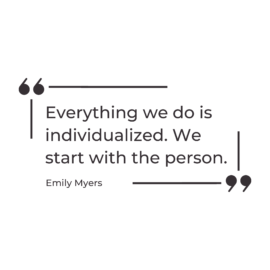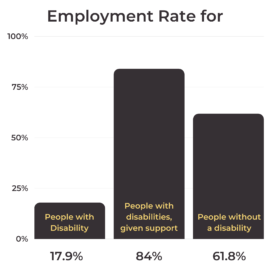
The Georgia Council on Developmental Disabilities (GCDD) interviewed Emily Myers, region director at Briggs & Associates, a supported employment company that assists people with disabilities with finding employment. We spoke about the state of work for people with disabilities, unemployment among people with disabilities, and what Briggs & Associates does to help individuals find meaningful and accommodating jobs and careers.
Georgia Council on Developmental Disabilities: Hello, Emily! Thank you for taking the time to speak with me today. First, could you please give me a brief overview of your background, as well as your job title?
Emily Myers: Sure! I am a region director with Briggs & Associates. I’ve worked with Briggs for 20 years. We are a supportive employment company; the only service we provide is employment, and we are entirely community-based. We meet with people at their homes and in their places of choice, wherever they’re most comfortable, and especially at their jobs.
GCDD: And when was Briggs & Associates founded? Could you give us a brief history?
EM: The company was founded in 1989, so we’re going on about “35-plus years,” as we say, in supported employment. It was definitely one of the earliest agencies to do what we do in Georgia. Supported employment was happening in some other places, but for the most part, the people we served were receiving their services in an institutional or group setting in a facility prior to supported employment. Our owner, Jennifer Briggs, who founded the company, was aware of the community-based programs and value of getting people out within their communities, with their neighbors and local businesses. She was working in a facility at the time, and she negotiated terms that allowed her to have one person get community-based services. She helped that person find a job and that person became more self-sufficient, so she asked to serve two people, and then three people. Ms. Briggs slowly grew the company by taking people out of an institutional setting and helped people get connected in their communities and get real jobs. Over the 35 years we have been in business, we have served thousands and thousands of people, about 8000 total to date. We currently work with a little over 900 people.
GCDD: What are some of the employment services Briggs & Associates provides to people with disabilities?
EM: Everything we do is individualized. We start with the person. We spend time with them, getting to know their likes and dislikes, their job history, things that they might like to do in the future, or things that they never want to repeat again.  We get to know clients in terms of who they are, even outside of a work setting, including how they interact with people, their attention to detail, anything. We learn about clients in ways that do not rely on preconceived notions, such as, “Wow, you are good with animals. You have to work with animals.” We start with the person first, and that leads us to the job. We help people create resumes and profiles, which we use to speak to employers on behalf of our clients. We are always trying to make connections with employers in new fields to broaden opportunities for the people we serve. We help people with their interviews and onboarding process, and finally, we help clients learn their job. We provide job coaching, and that involves helping the person fit into the employer’s expectations and how the employer teaches the job. If the person needs accommodation, we will assist with negotiating that on their behalf. Finally, we start to fade out once the person becomes self-sufficient in their job, with us checking in once a week to ensure both parties are satisfied.
We get to know clients in terms of who they are, even outside of a work setting, including how they interact with people, their attention to detail, anything. We learn about clients in ways that do not rely on preconceived notions, such as, “Wow, you are good with animals. You have to work with animals.” We start with the person first, and that leads us to the job. We help people create resumes and profiles, which we use to speak to employers on behalf of our clients. We are always trying to make connections with employers in new fields to broaden opportunities for the people we serve. We help people with their interviews and onboarding process, and finally, we help clients learn their job. We provide job coaching, and that involves helping the person fit into the employer’s expectations and how the employer teaches the job. If the person needs accommodation, we will assist with negotiating that on their behalf. Finally, we start to fade out once the person becomes self-sufficient in their job, with us checking in once a week to ensure both parties are satisfied.
GCDD: Could you walk us through some of the various challenges that Briggs & Associates seeks to address? 
EM: According to the Centers for Disease Control and Prevention (CDC), about 6.5 million people in the United States have an intellectual disability. Without support, challenges exist for these individuals, including a very high unemployment rate and often being underemployed or working in low-wage jobs. According to the Bureau of Labor Statistics (BLS), the employment rate for people with a disability is 17.9%. The Briggs employment rate for individuals with disabilities, given support, is approximately 84%. For people without a disability, the employment rate is 61.8%. Clearly support makes a difference! We make a very strong case for the benefits of hiring our clients. The people who we serve tend to do jobs the way they were taught, to have better attendance rates, and tend to have lower turnover rates. We stay long-term with employers, so we are always involved in the person’s career, so the employer can rest assured knowing they have a team on their side.
GCDD: What would you recommend to employers who are looking to make their workplaces more inclusive for those with disabilities? What can they do to engage or hire more people with disabilities?
EM: To start, I do want to mention that there has been a rise in diversity, equity and inclusion (DEI) programs, initiatives and departments in recent years. We have really embraced that opportunity, and we speak with employers and help them see that we are part of the solution to some of the goals they may have set in that area. We want disability to be a part of that conversation. Also, we want employers to understand that it is not a huge leap. If someone needs an accommodation, it can be something as simple as a chair or a different type of keyboard. It’s not something that should be a dealbreaker for hiring a person. We work with the Georgia Vocational Rehabilitation Agency (GVRA) to get the tools and technology necessary to assist the people we serve. I think the most important thing is to know that we will do the heavy lifting. An employer doesn’t have to take on a whole lot more.
GCDD: On the other side of the hiring process, what should people with disabilities know about getting in touch with Briggs & Associates or seeking employment in general?
EM: One thing I would encourage is to get involved early. There’s a planning list for people in the State of Georgia who want services. Parents need to get involved with this list. Families should start asking schools early on about the options for transition or about post-graduate services that are available to their child. Usually, toward the middle of high school, schools will offer a community-based instruction program, so I would encourage families to get their children involved in those programs. They get everybody thinking about employment! As children reach the end of school, families will start to hear from the Department of Behavioral Health and Developmental Disabilities (DBHDD), and if they don’t, they need to contact them to verify their status. Ideally, that student will be able to transition right into a service provider, like Briggs & Associates, after they finish school. It’s essential that the student doesn’t miss time between school and work, because they lose skills they built in school. We partner with school systems in hopes of catching students before they lose those skills. People are also always welcome to call us at 770-993-4559 or email us at briggscentral@briggsassociates.org. We can help them navigate some of those channels. It can be overwhelming for families, but our office is always happy to help.
To learn more about Briggs and Associates, visit https://www.briggsassociates.org/wordpress/ or email us at briggscentral@briggsassociates.org.
